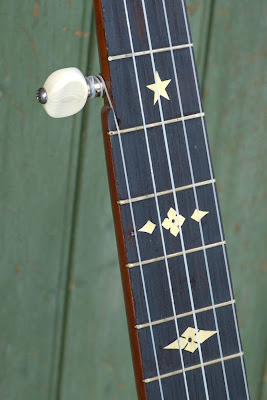c.1895 Buckbee-made "Venus" 5-String Banjo
Update 2013: I've just updated the photos and information on this 5-string. I've owned this since February '09 and it's been a great, reliable, well-traveled instrument (used in a number of pick-up bands and a few stage productions).
This banjo was certainly made in the J.H. Buckbee (later, Lange) factory in New York as it shares all of the common features of many other Buckbees I've both seen and worked on: "boat" heel shape, spunover rim, thin ebony fretboard, thin and fast C-shaped neck profile, double-bubble headstock shape, and wider-than-normal nut and fretboard overall (more of a "classical" feel which suits nylon/gut strings).
Work on it over time has included: new friction pegs all around with nice ivoroid buttons, fret level/dress, much cleaning, new skin head and Grover bridge, new neck brace shim, and of course setups and whatnot. It plays beautifully with appropriate (for gut/nylon) 3/32" action at the 12th fret. The neck has a tiny bit of relief in the 1-5 frets but that's pretty much the norm on most 5-strings from this time since so many of them were strung with steel for parts of their lives (banjos from this era are purely gut/nylon instruments). It's been stable since I've had it and doesn't effect good playability.
This is the classic Buckbee headstock shape which was also used by a few other makers, most notably Oscar Schmidt, but they're all not "quite the same" as this elegant cut.
Note that I have a "railroad spike" installed at the 7th fret to allow raising the 5th string to an A when you capo on the 2nd. The inlays are all early "ivoroid" material (or possibly ivory, though I sort of doubt that) and look quite nice. The board itself is very, very thin ebony and shows finger-wear here and there.
The Venus inlay is very cool. The only instrument that I've seen that comes close was a slightly longer-scale instrument that was pretty much the same but sported a "Jupiter" inlay instead.
The new thin-skin head sounds great and has a lovely "cloud" look to it that gives it authenticity.
Newer ebony/maple Grover bridge. The strings are Aquila Nylguts and sound great.
The rim hardware is all original including this lovely brass "Bookser's Patent" tailpiece that lets you load the strings easily after knotting them.
Nice, nickel-plated brass hardware all around. The rim is spunover with hoops on either side, thus creating an integral "Little Wonder" style tonering on the top edge of the rim. This gives a good, sustained, sweet, bright, and loud tone to the instrument. I've often noticed in jams that this substantially outvoices similar steel-string openbacks of the same overall design.
Do you see how elegantly that neck is carved? It has original finish throughout, too, in great shape. The neck is mahogany, by the way.
There's that beautiful "boat" heel.
These are good-quality friction pegs and have replacement, vintage-looking ivoroid buttons.
5th peg is also friction and works just fine.
The mounting hole for the dowel was drilled a second time in the past to re-angle the neck-to-pot joint. It's perfectly stable but the old hole is still there.
Here's the neck brace shim: one piece of ebony in a triangular slot which tightens up the neck to the pot. This is an ingeniously simple and practical design and far better than the screwed-on mounting style so typical of this period of banjo.
The hardware is lovely!





















Comments
I seem to have a similar banjo, especially the pot, neck and inlays. Only it has a 5th peghole in the middle of the peghead that seems original and it has a flush fret fingerboard with the "frets" of seeming the same material as the inlays. I posted it on the banjo hangout once http://www.banjohangout.org/archive/273552
I have never encountered a similar banjo, so could you help me to identify it? If necessary, I could post additional photos.
Thanks for a reply
Huub Verheijden
Maastricht
The Netherlands